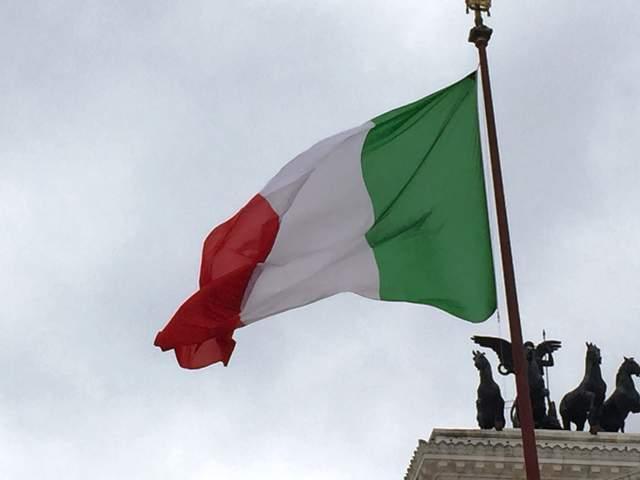Where All Roads Lead
The Italian flag flies next to the Altare Della Patria, a national monument dedicated to King Victor Emmanuel II, the first king of a united Italy. The gigantic building is adorned with Corinthian columns, fountains, two rooftop statues of the Goddess Victoria riding on quadrigas (chariots led by four horses abreast), and a statue of the king himself. Police stood inside the monument to ensure that crowds did not linger by it for too long.
May 4, 2015
The plane rumbled and shook as the mass of steel struggled to slow down. Beside me, a woman sat fast asleep, the child next to her playing a game on her mother’s phone. I did not speak to them during the entire flight. I could not. I spoke only English, and they spoke only Italian. The intercom blared to life, a voice announcing something in Italian as I fumbled with the breadsticks the flight attendants handed to me. Moments later, he spoke again, declaring that the plane was in descent and that all passengers should sit in their seats with their seatbelts buckled. I let out a heavy yawn and toyed with the zipper of my hoodie. Groggily, I rubbed my eyes as I sat upright, watching the yellowish lights as they swam through the sea of black landscape. As the plane lowered, more detail came into view. Cars and trucks lumbered down the Roman streets as I watched from above, descending into the Eternal City.
One of the most striking things I saw in the City on Seven Hills was the Pantheon. The Pantheon, more than anything else I saw in Rome, exemplifies the movement of time from the Ancient Roman period to the modern day. The temple itself was constructed by the polytheistic Romans when Christianity was little more than one of many minor faiths in the Mediterranean. However, when Christianity became the state religion of the Roman Empire, the Pantheon no longer served the believers of Jupiter and Minerva, but instead served the believers of Jesus as a church. When the Roman Empire collapsed, the Pantheon’s role as a church allowed it to escape the destruction and dismantlement that befell many Ancient Roman buildings. During the Italian Renaissance, painter and architect Raphael requested that he be buried inside the Pantheon. His tomb remains there to this day. In 1878, Victor Emmanuel II, first king of a united Italy in over one thousand years, died and was buried in the Pantheon. The Pantheon, which still holds religious services to this day, embodies almost the entirety of Italian history.
While there was much to see about the city of Rome, one thing was very particular: its beauty. Tall and elaborate buildings dominated the skyline. The narrow streets snaked through the mass of buildings, and were filled with outdoor cafes, shops where goods could be easily seen by pedestrians, and fascinating sights. Occasionally, the streets would link together into public squares known as piazzas, which ranged in size from small and secluded open areas to enormous epicenters of activity. Just walking around and exploring the city was perhaps my favorite part about Rome.
Often, while navigating the city, I would come across some random ancient building from eras past. For example, after departing the piazza by the entrance to the Pantheon, I came across a building of ivory-colored stone, clearly older than its surroundings. In front of the building, which I suspect may be a church, a peculiar sculpture graced my eyesight. It was an obelisk, topped by a cross, sitting atop the back of an elephant. The sculpture itself was almost as tall as the building behind it. I had stumbled across this building entirely on accident. That in itself was a wonder of exploration.
Worshippers holding umbrellas crowded near St. Peter’s Basilica for Easter Sunday as I stood on a bridge further down the Tiber River, only a few hundred meters from the centerpiece of the faith of over one billion people. Raindrops rattled the grey waters of the Tiber River, and the trees that lined the sidewalks to my left hunched over the edge. Below me stood a walkway at the very edge of the river, completely empty except for a thick layer of vibrantly green moss. The Basilica in front of me towered over everything nearby, and on this day especially it was surrounded by a mass of people from all over the Catholic world. Vatican City was practically inaccessible due to the crowd.
My trip to Italy was my first time out of the United States, and it was an amazing experience to meet and see people born and raised halfway across the world. The people were surprisingly kind, despite my occasional stupidity as a tourist. The city of Rome is a vastly distinct city from those in the United States. My first visit to Europe has sparked a desire in me to return to the continent across the pond.




